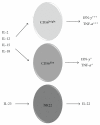NK cells and psoriasis
- PMID: 21687543
- PMCID: PMC3114545
- DOI: 10.1155/2011/248317
NK cells and psoriasis
Abstract
Psoriasis is a chronic condition of the skin characterised by distinctive scaly plaques. The immune system is now thought to play a major role in the development and pathogenesis of psoriasis with immune cells and cytokines influencing keratinocyte function. Keratinocytes in turn, can activate and recruit immune cells leading to a positive feedback loop in disease. Natural Killer (NK) cells are lymphocytes that are best known for killing virally infected and cancer cells. However, evidence is emerging to support a role for NK cells in psoriasis. NK cells are found in the inflammatory infiltrate in psoriatic skin lesions. They can produce a range of inflammatory cytokines, many of which are important in the pathogenesis of psoriasis. Recent genetic studies have identified a range of potential molecules relating to NK cell biology that are known to be important in psoriasis. This paper will discuss the evidence, both cellular and genetic, for NK cell involvement in psoriasis.
Figures


References
-
- Nestle FO, Kaplan DH, Barker J. Mechanisms of disease: psoriasis. The The New England Journal of Medicine. 2009;361(5):444–509. - PubMed
-
- Lowes MA, Bowcock AM, Krueger JG. Pathogenesis and therapy of psoriasis. Nature. 2007;445(7130):866–873. - PubMed
-
- Lebwohl M. Psoriasis. The Lancet. 2003;361(9364):1197–1204. - PubMed
-
- Schön MP, Boehncke WH. Psoriasis. The New England Journal of Medicine. 2005;352(18):1899–1912. - PubMed
-
- Liu Y, Krueger JG, Bowcock AM. Psoriasis: genetic associations and immune system changes. Genes and Immunity. 2007;8(1):1–12. - PubMed
Publication types
MeSH terms
Substances
LinkOut - more resources
Full Text Sources
Other Literature Sources
Medical

